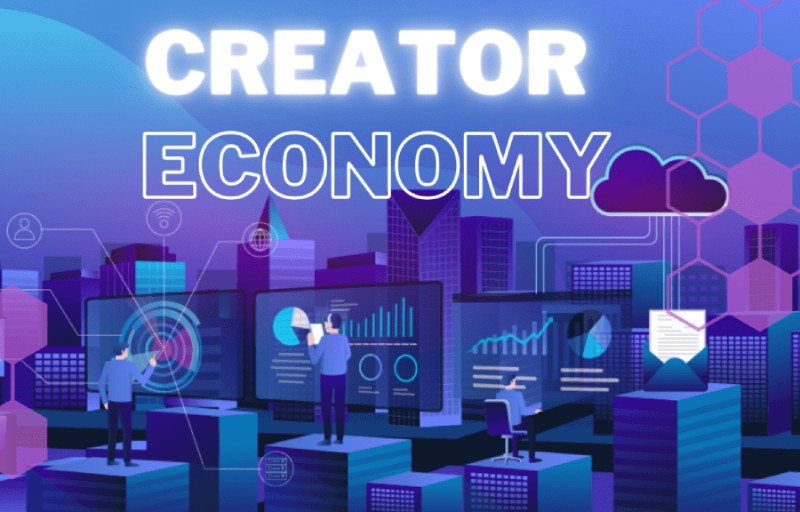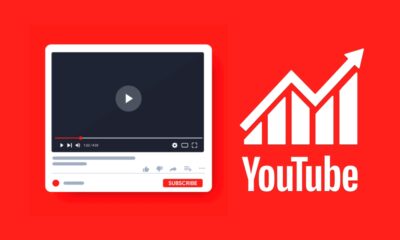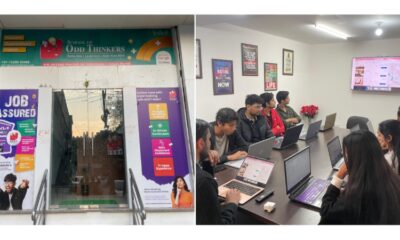Business
Key Takeaways & Advantages of Understanding the Creator Economy

The term “creator economy” refers to a paradigm shift in which people use social media and the internet to establish direct relationships with their audiences. This includes influencers, independent artists, and educators. This economy, in contrast to traditional business models, is driven by authenticity, creativity, and the strength of specialized communities.
It is essential to comprehend the creator economy whether you are a company trying to get into this exciting market or an aspiring content creator. Let’s examine its fundamental elements, consider its effects on different industries, and offer advice on how to traverse this innovative landscape successfully.
Overview of the Creator Economy
The way people create and monetize original content has undergone a radical change thanks to the creator economy. The creator economy is based on the strength and reach of digital and social media platforms, in contrast to traditional production companies that depend on large-scale operations and substantial resources. Individual creators are now empowered by this new economic model to transform their passions and creative pursuits into sustainable careers.
Fundamentally, the creator economy is predicated on the notion that anyone possessing a special viewpoint, ability, or talent can produce and disseminate content to a global audience. Content creation has become more accessible thanks to websites like YouTube, and Instagram, which let creators communicate directly with their fans without the need for traditional gatekeepers. Apart from providing the necessary tools for content creation, these platforms also present an extensive array of income opportunities, ranging from sponsorships and ad revenue to merchandise sales and membership subscriptions.
Multiple key factors are propelling the growth of the creator economy. Firstly, the proliferation of social media platforms has made it simpler than before for creators to spread the word about their work and expand their follower base. Second, more people can now pursue creative endeavors without the need for costly equipment or dedicated studio space thanks to technological advancements that have lowered entry barriers.
Current market trends emphasize its potential and quick growth. Recent data highlights the substantial financial opportunities open to individual creators, with the global influencer marketing market alone expected to reach $15 billion in 2022. Furthermore, digital platforms have a significant impact on content consumption; as evidenced by the fact that over 2 billion logged-in users visit sites like YouTube each month.
Understanding the economy’s fundamental components and how to best utilize them is crucial as more people come to appreciate its worth and possibilities. Creators can turn their original content into successful businesses and leave a lasting impression in their fields by seizing the opportunities presented by digital and social media platforms.
Essential Elements of the Creator Economy
Anyone hoping to prosper in this ever-changing environment must comprehend the fundamentals of the creator economy. The key elements of the creator economy are examined here, including the different kinds of content creators, the platforms and tools they employ, and the range of revenue streams that are open to them.
Types of Content Creators
The core of the creator economy is its content producers. These people work in influencer, artistic, educational, and entertainment fields, among many others. With varying target audiences in mind, every kind of content creator approaches their craft differently. Beauty influencers, for example, post makeup tutorials, and educators offer online courses and tutorials. In the creator economy, there is something for everyone thanks to this diversity of content.
Content Creation Platforms and Tools
The infrastructure for content creation and distribution is provided by well-known platforms like Patreon, Instagram, TikTok, YouTube, and others. These platforms give content creators access to a wide range of tools, such as live streaming and video editing software, so they can produce engaging content for their intended audience. These platforms enable the distribution of content and present prospects for monetization in the form of sponsorships, ad revenue, and direct fan support.
Revenue Streams for Creators
The range of income streams that creators can choose from is one of the most distinctive aspects of the creator economy. Individual creators have the ability to diversify their revenue streams through various channels, in contrast to traditional production companies. Important sources of income consist of:
- Ad Revenue: Earnings from showing ads on websites like Instagram and YouTube.
- Sponsorship: An important aspect of influencer marketing is collaborations with companies that pay creators to promote their goods or services.
- Merchandise Sales: Providing fans and followers with direct access to branded merchandise.
- Membership Subscriptions: Providing Patreon users with access to exclusive content or additional benefits.
Because of these diverse revenue streams, creators can reinvest in their work and expansion while also enjoying financial stability.
The Role of Influencer Marketing
Influencer marketing, which closes the gap between brands and creators, has emerged as a key component of the creator economy. In their specialised fields, influencers who have amassed devoted fans are regarded as reliable sources of information. In contrast to traditional advertising, brands work with these influencers to reach specific audiences more genuinely and compellingly.
The Impact of the Creator Economy on Industries
The rise of the creator economy has had a significant effect on several industries, radically changing conventional business models and encouraging innovation in all fields. The broad use of online platforms, the diversity of content kinds, and the new monetization strategies that support independent content producers and creators are the main forces behind this shift.
Evolution of Traditional Media and Production Studios
Once having the exclusive right to create and distribute content, independent creators now face competition from traditional production studios as they use digital platforms to reach large audiences. The media has become more democratic as a result of this change, giving rise to a wider range of voices and innovative ideas.
Evolution of Marketing and Advertising Techniques
The impact of the creator economy on marketing and advertising tactics has been substantial. Influencer marketing platforms are becoming a more popular choice for brands looking to promote their products on social media. When it comes to reaching target audiences, influencers with devoted followings are a more genuine and captivating option than traditional advertising. Businesses now work with influencers in a variety of fields, such as tech, gaming, and fashion as well as beauty and fashion, to reach specialized customer groups.
Innovative Monetization Models
The core of the creator economy is new monetization models that give content creators multiple sources of income. In addition to traditional advertising, other sources of income include sponsorship agreements, product sales, subscription services, and direct fan support through websites. By allowing creators to attain financial stability and reinvest in their work, these various monetization strategies promote a continuous cycle of innovation and growth.
Impact on Niche Markets and Communities
Content creators can create customized content for particular audiences and interests using online platforms. As a result, lively online communities based on diverse interests, occupations, and lifestyles have grown. These niche markets offer brands lucrative chances to interact with very specific audiences using community sponsorships and influencer partnerships.
Techniques for Becoming Successful in the Creative Economy
A strategic approach to content creation, audience engagement, and monetization is necessary for success in the creator economy. Digital creators can use the following important tactics to succeed in this changing environment:
- Diversify Content Formats
The key to attracting and keeping social media users’ attention is to diversify your content formats. To achieve this, create a variety of content, including live streams, podcasts, blog posts, infographics, and videos. Your audience will respond differently to different formats, which will boost engagement overall. Videos are still the most engaging kind of content, according to a 2024 report. Compared to text and image posts combined, social media videos receive 1,200% more shares.
- Make Use of Content Management Systems
Managing and distributing new content across multiple platforms in an effective manner is essential. This procedure can be streamlined with content management systems (CMS) such as HubSpot, WordPress, and Contentful. Digital creators can monitor performance, plan content, and guarantee consistency across all platforms with the aid of these systems. By using a CMS, content producers can devote more of their attention to production rather than management.
- Emphasize Authentic Content
To gain your audience’s trust and loyalty, you must be genuine. Users of social media are beginning to favor more real content over highly produced, marketed content. You can establish a stronger bond with your audience by sharing personal stories, unfiltered moments, and behind-the-scenes photos.
Participate in Conversation with Your Audience
A vital aspect of success in the creator economy is audience engagement. Creating excellent content is not enough to develop a devoted following; you also need to know your audience’s preferences, engage with them regularly, and create a feeling of community. The following are some essential techniques for connecting with your audience:
- Recognize the Preferences and Demographics of the Audience
Understanding the demographics of your audience is essential to creating content that appeals to their preferences and interests. To learn more about the age, location, gender, and interests of your followers, use the analytics tools that social media platforms provide. By using this data to inform your strategy, you can make sure that the content you produce speaks to the people in your target market.
- Give Content Quality First Priority
A key factor in keeping and expanding your audience is the quality of your content. High-quality content caters to the interests and needs of your audience while being useful, interesting, and helpful. To keep your content current and interesting, update it frequently. By consistently producing top-notch content, you can become recognized as an authority in your field and build a devoted following of readers who appreciate your ideas and original works.
- Create a Community Dedicated to Your Content
Proficient digital creators can effectively foster communities as well. Urge your audience to engage with one another as well as with you. Establish online communities, forums, or groups where readers can converse about subjects linked to your work. This improves audience loyalty and fosters a sense of community among your audience in addition to increasing engagement.
Navigating the Creator Economy
Anyone hoping to prosper in this dynamic and quickly changing environment must grasp “What is The Creator Economy.” The production, distribution, and monetization of content by independent creators have been transformed by the creator economy, creating new opportunities for both career and personal advancement. Creators can establish long-lasting and lucrative careers by utilizing a variety of content formats, leveraging online platforms, and effectively engaging with their audiences.
Success requires a constant state of awareness regarding industry trends, audience preferences, and content strategy optimization. Content creators have numerous opportunities to make a big difference in the creative economy and accomplish their financial and creative goals. This is especially true as the industry grows.
-

 Gadget4 weeks ago
Gadget4 weeks agoAfter Grand Success on BLDC Ceiling Fan, Eff4 Is Launching Smart Bulb
-

 Festivals & Events4 weeks ago
Festivals & Events4 weeks agoGoogle Celebrates Cherry Blossom Season with Animated Doodle
-

 Business2 weeks ago
Business2 weeks agoPrakash and Kamal Hinduja: Driving Social and Environmental Change
-
Education3 weeks ago
Fred DuVal: University Leadership as a Critical Resource for Climate Change Research and Life-Saving Solutions
-

 Health2 weeks ago
Health2 weeks agoThe Hinduja Brothers Commitment to Global Health: Empowering Communities Across Borders
-

 Cryptocurrency3 weeks ago
Cryptocurrency3 weeks agoDesigned For The Masses: How Akasha (AK1111) Is Unlocking Crypto For The Next Billion Users
-

 Cryptocurrency3 weeks ago
Cryptocurrency3 weeks agoNexaglobal & Future World Token (FWT): Could This Be the Next Big Crypto Investment of 2025?
-

 Sports4 weeks ago
Sports4 weeks agoWomen’s NCAA Tournament 2025 Sweet 16: Full Schedule, Fixtures, Teams, Bracket, and How to Watch March Madness Basketball Match Live

























